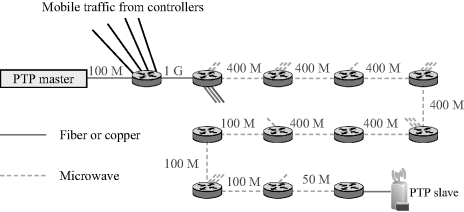6.6 Rules of Thumb for Packet Timing Network Implementation
At the time of writing, the delay variation effects in complex networks have not been studied thoroughly enough for estimating delays at the fine-grain accuracies required for timing purposes. A network can be assessed by carrying out delay measurements over multiple connections at different load conditions. Unfortunately, just after building the network the loading is still much less than it will be after some time. However, for example MAFE and pktfilteredMTIE produce quantitative results where the margin between the limit and delay variation can be observed. If at a later measurement the margin has become clearly smaller, then some links might need upgrading.
Experience so far indicates that if the packet timing slaves are good enough, there is no need to decentralize time servers to the edges of the transport network. The path in Figure 6.31 is part of a commercial deployment. There are two copper/fiber Ethernet links followed by ten packet microwave radio (MWR) links.
Figure 6.31 Example of a path in a commercial MWR backhaul deployment.

Although the implementation above has worked well, it cannot be taken for granted that all such implementations will work. An example set of rules for 16-ppb clock accuracy target and G.823 2-Mbit/s traffic mask is given below. The values match with a packet clock that has a 10000-s ...
Get Mobile Backhaul now with the O’Reilly learning platform.
O’Reilly members experience books, live events, courses curated by job role, and more from O’Reilly and nearly 200 top publishers.

